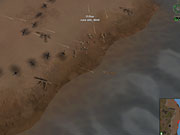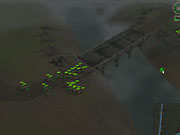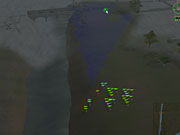World War II: Frontline Command is a real-time strategy game from a developer that is known more for its style than its substance. Developer Bitmap Brothers previously created Z and its sequel, Steel Soldiers. Z's claim to fame was its zany sense of humor, but it was still a traditional real-time strategy game, and Steel Soldiers was a rather average game too. The company's latest game, World War II: Frontline Command, does have some new ideas, but these concepts--and some of the game's more-standard real-time strategy mechanics--aren't implemented well.

Frontline Command is another World War II strategy game in which you command squadrons of units that are provided to you at the beginning of each mission, rather than produced from structures you must build. The game's missions require you to complete objectives such as destroying bridges, clearing bunkers, and knocking down radar towers. Strategy games of this sort are supposed to remove resource management from the picture, allowing tactics to take center stage. Frontline Command lets you use 23 different units on the Allied side (the only playable side in the single-player mode), and it features some interesting twists on the standard RTS formula, though some of these innovations don't work as well as they might have.
For instance, one of the innovative mechanics that works well is the game's fog of war. In Frontline Command, the fog of war actually looks and behaves like fog, and things like elevated areas and large objects can block your sight. Furthermore, some units have a wider range of vision than others, and units can be paired up to take advantage of their collective line of sight. However, the fog of war goes hand in hand with the game's treatment of unit sound, which doesn't work quite as well. In Frontline Command, soldiers can detect their enemies by sound as well as by sight. So, for example, crawling infantry are difficult to detect because they are both harder to see and less noisy. Unfortunately, there's no way to effectively gauge how much noise your units are hearing--there's no audio meter or anything like that. If your enemies do make noise, you'll be able to see their health bars even though you can't see the actual units, but it doesn't seem like this mechanic is as fleshed-out as it could have been.
Frontline Command also features an unusual morale system. With high morale, you can perform heroic actions that boost your units' combat effectiveness. High morale can come from trouncing enemies, destroying key objectives, and keeping your troops healthy. Similarly, injured troops are less effective and drag down company morale, so you always need to keep paramedic trucks on hand to heal injured units. In practice, the connection between health and morale means that battles can come to a close very quickly once things stop going your way.

But you may have a hard time appreciating Frontline's innovative features because of the game's pathfinding and interface problems. For instance, though it's easy to select a small group and direct its movements, selecting a large group of units and ordering them to a destination will often result in one part of the group on the other side of a nearby river, another part on the wrong side of a chain-link fence, and still another part stuck behind a bunker. It's possible to manually select each unit and order it to converge on your destination, but this process is far too cumbersome to be useful. The game also has other, more-minor interface issues, such as the fact that it displays an individual unit's firing range, but doesn't do so for a selected group. Also, the game doesn't let you manually order your troops to attack any hostile enemies they encounter while moving, or to return fire while moving, but your units will sometimes do these things themselves. Furthermore, you can't check your mission objectives once a mission is under way, and some of the objective briefings provide erroneous information, such as in a mission that supposedly requires engineers to destroy a radar tower that can easily be destroyed with infantry grenades.
Despite its flaws, Frontline Command's interface does feature a few interesting ideas. You can issue orders to your units using a radial menu (similar to the one in BioWare's RPG Neverwinter Nights) that allows you to give special orders to specific units, such as changing to defensive mode, which provides a massive armor bonus but limits attacks to a single direction, or ambush mode, which provides a massive attack bonus but also limits attacks to a single direction. You can also use this menu to order trucks to haul artillery and order troops to board transports, enter buildings, or force-fire on a specific spot.

Unfortunately, you'll need to use the force-fire option often, since your units may not always attack nearby enemies. For example, sometimes mortar infantry will move rather than fire their long-range mortars. But even force-fire is inconsistent--sometimes units with force-fire orders will become stuck in one place, firing repeatedly on a single area, and other times they'll fire once and stop, so you'll have to go in and baby-sit your units to make sure they continue firing. The game's radial menu groups this and other commands into a single place, but having to open and reopen the radial menu for every last unit and group can be cumbersome, especially with large groups of units.
Most of Frontline Command's units have secondary attacks that are triggered using icons in the lower-left corner of the screen. The secondary attacks tend to be useful, varied, and unique, but the interface severely hampers their use. To activate a secondary attack, you must click the corresponding icon in the corner of the screen, but you can click only one icon at once, and if you have many different types of units in a group, which is common, it's impossible to effectively use all your secondary attacks. It's also very easy to end up inadvertently scrolling the map while trying to click on one of the small secondary attack icons. Though the placement of these icons keeps the interface from obscuring the battlefield, that's not much of a benefit when you have to hunt down every last little button.
Frontline Command doesn't make much of its nondescript, overused World War II setting. Graphically, Frontline Command seems to be based on the engine used for Steel Soldiers, which was released in 2001. Though the new game features more graphical detail, it's still difficult to distinguish between the two, and overall Frontline Command is rather bland. Fortunately, the game makes up for some of its visual inadequacies with its sound, consisting of a strong musical score and deep, rumbling sound effects on the battlefield.
Though the single-player game simply follows the war chronologically, it does have some very enjoyable levels. The missions themselves seem somewhat clichéd, but they can be fast-paced and quite immersive at times. The entirely Allied-focused single-player campaign spans from the battles surrounding D-Day to the final push toward Berlin. The three major missions, D-Day, the Battle of the Bulge, and Berlin, are all suitably massive. In fact, the sheer enormity of these operations, which give you dozens of units to control, is enjoyable in itself. With so many units on the battlefield, there's almost no time to worry about the imprecise and problematic interface, and you may even forget some of the game's problems, at least momentarily. But these missions are few and far between. In the game's other missions, stealth and silence are often crucial, so many of these missions devolve into slow crawls across the maps that are sometimes suspenseful but often tedious. 
There are other strategy games set during World War II that offer a more-consistent experience and better value. Frontline Command offers a single Allied campaign that consists of 12 missions on regular difficulty. The veteran difficulty setting opens up more missions and makes the repeat missions more difficult, but you might wish for an Axis campaign--or an instant-action skirmish mode, because Frontline Command doesn't have that, either. Even though you can play as the Axis in multiplayer, the game's multiplayer modes aren't especially robust, since only four players can play in one game, no computer opponents can be added, and there are very few custom multiplayer settings available. As such, the game's multiplayer modes don't offer much in the way of variety or replay value. Then again, if you can forgive its unimpressive multiplayer and its problematic interface, Frontline Command's innovative features and gameplay depth may make it worth the trouble.